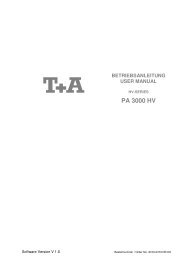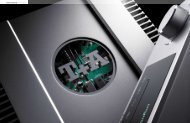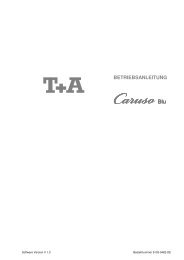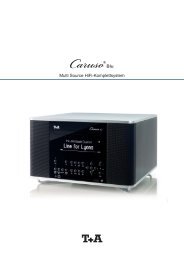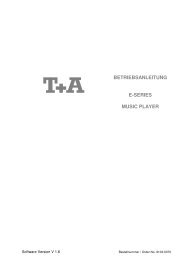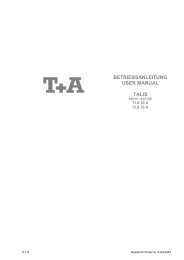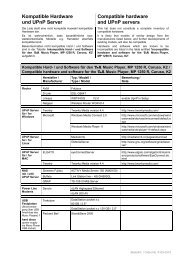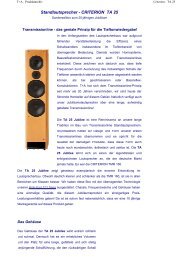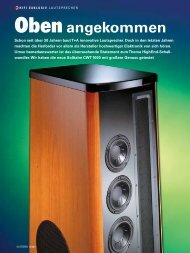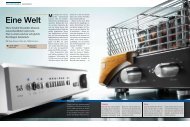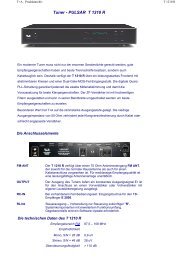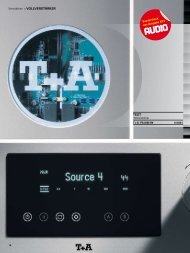T+A E-Series Music Player balanced(£2890) - T+A Elektroakustik
T+A E-Series Music Player balanced(£2890) - T+A Elektroakustik
T+A E-Series Music Player balanced(£2890) - T+A Elektroakustik
Create successful ePaper yourself
Turn your PDF publications into a flip-book with our unique Google optimized e-Paper software.
MEDIA PLAYER<br />
There’s probably no direct<br />
translation for ‘Heath Robinson’<br />
engineering in German. If the likes<br />
of Burmester and <strong>T+A</strong>, featured<br />
here, are any guide, then it would suggest<br />
our Teutonic cousins simply don’t do<br />
‘hairshirt’ hi-fi. For not only is this E-<strong>Series</strong><br />
variant of <strong>T+A</strong>’s <strong>Music</strong> <strong>Player</strong> beautifully<br />
engineered and finished, it’s also<br />
deceptively comprehensive. I mean, you’ve<br />
really got to squint before noticing there’s<br />
a CD drive underlining that exquisite<br />
fluorescent display. So not only is this a<br />
five-input DAC, a USB hub for iPod and high<br />
resolution audio stored on standalone<br />
hard drives, a UPnP network client for<br />
computer-sourced streaming, an internet<br />
radio and analogue FM tuner – it’s also a<br />
silver-disc spinner.<br />
BoxIng cLEvER<br />
Hence the all-encompassing product<br />
description ‘<strong>Music</strong> <strong>Player</strong>’, the <strong>balanced</strong><br />
suffix a reference to the symmetrical circuit<br />
topologies that are the foundation of its<br />
design. In practice, while <strong>T+A</strong>’s engineers<br />
cut their collective teeth on loudspeakers<br />
[see boxout], their experience in the<br />
digital domain still stretches back a couple<br />
of decades. It was the CD1210R player<br />
that, along with models from Sony, first<br />
offered audiophiles the facility of switching<br />
between different oversampling filter<br />
algorithms. That was in 1998 – the first<br />
and last time I saw an example of <strong>T+A</strong>’s<br />
inventiveness available in the UK.<br />
The intervening period has not seen<br />
<strong>T+A</strong> idle, as this all-in-one, line-level<br />
digital player serves to demonstrate. The<br />
<strong>Player</strong> is joined by a matching integrated<br />
amp, called the Power Plant <strong>balanced</strong>,<br />
REPRINTED FROM HI-FI NEWS | www.hifinews.co.uk<br />
CD player/DAC/USB/network audio media server and tuner<br />
Made by: <strong>T+A</strong> elektroakustik GmbH & Co. KG, Germany<br />
Supplied by: Acoustic Brands Ltd<br />
Telephone: 07917 431280<br />
Web: www.taelektroakustik.de; www.acousticbrandslimited.com<br />
<strong>T+A</strong> E-<strong>Series</strong> <strong>Music</strong> <strong>Player</strong><br />
<strong>balanced</strong> (<strong>£2890</strong>)<br />
A leading light of the German hi-fi scene, <strong>T+A</strong> is once again available to UK audiophiles.<br />
We kick-off our tour of the brand with this versatile all-in-one CD and media player<br />
Review & Lab: Paul Miller<br />
RIgHT: Not a mini PC but a high-end CD player/<br />
DAC with FM/internet radio, USB and network<br />
audio functions added. The player supports<br />
modern file formats (up to 24-bit/192kHz)<br />
including WAV, WMA, AAC, FLAC and Ogg Vorbis<br />
and a receiver that effectively combines<br />
the technology of the pair. But, for the<br />
audiophile (or ‘audio freak’ in <strong>T+A</strong>’s<br />
unfortunate parlance), it’s this line-level<br />
Media <strong>Player</strong> that really represents <strong>T+A</strong>’s<br />
premier source component. And for good<br />
reason, for not only is it extremely versatile,<br />
exceptionally slick and glitch-free in<br />
operation but it offers a performance that<br />
belies the complexity, and opportunity for<br />
mutual interference, otherwise suggested<br />
by these high levels of integration.<br />
Even the rounded contours and<br />
dovetailed construction of its lacquered<br />
alloy case are as much a function of CE<br />
compliance as aesthetic statement, the<br />
black plastic side-cheeks merely a cosmetic<br />
addition. <strong>T+A</strong> has also succeeded in<br />
minimising clutter on its fascia without<br />
losing functionality to the remote control.<br />
The four main input buttons select Disc<br />
(CD player), Radio (internet and FM), SCL<br />
(Streaming Client – anything connected<br />
via the network or two USB ports) and Dig<br />
(three 192kHz capable coaxial inputs and<br />
two 96kHz optical inputs). The menu and<br />
‘crosshair’ buttons to the right then allow<br />
you to navigate through various set-up<br />
options as well as the precise connection<br />
of the selected input.<br />
The VFD screen is especially smart,<br />
combining a main display field that carries<br />
key text/descriptive information about the<br />
music in play, a vertical strip to the right<br />
that shows information about the device/<br />
network/reception status and a horizontal
strip below that carries supplementary,<br />
context-sensitive data. The display has<br />
seven levels of brightness and may be<br />
configured in several languages.<br />
THE SMALL PRInT<br />
There are, of course, numerous hidden<br />
features within the Media <strong>Player</strong>’s menus.<br />
Digitally-governed <strong>balanced</strong> and bass/<br />
treble tone controls supplement the<br />
physical up/down volume buttons on the<br />
fascia, although the latter are only enabled<br />
if you have the optional £200 preamp<br />
board fitted. With or without variable<br />
outs, the <strong>Player</strong> feeds both single-ended<br />
and <strong>balanced</strong> connections – although the<br />
preamp does allow it to be connected<br />
directly to a power amp of your choice.<br />
Of greater interest, perhaps, is the<br />
built-in option of two oversampling filters,<br />
the first a conventional high-order FIR type,<br />
the second a low-order ‘Impulse Optimised’<br />
type not dissimilar to the Wadia/Pioneer<br />
Legato Link filters of yore [see Lab Report].<br />
The menus also allow customised input<br />
naming, the option of phase inverted<br />
outputs and configuration of both wired<br />
and wireless network connections.<br />
The latter is not especially suitable for<br />
streaming hi-res 96kHz or 192kHz files, I<br />
TRAILBLAZIng <strong>T+A</strong><br />
might add: wherever possible, stick to a<br />
wired LAN and use WAV or FLAC file types.<br />
While we’re on the subject of small<br />
print, I should add that although the <strong>Player</strong><br />
accepts all digital input sample rates, files<br />
at 88.2kHz and 176.4kHz are indicated<br />
erroneously as 96kHz and 192kHz on its<br />
display. Also, while a wealth of metadata is<br />
displayed with USB or network-connected<br />
audio (all save album artwork), it is the<br />
file size rather than sample rate that’s<br />
indicated. Not that a download’s sample<br />
rate is necessarily a<br />
reliable indication of<br />
its native bandwidth,<br />
I’m bound to add [see<br />
HFN Jun ’11 and hi-res<br />
download reviews, p82].<br />
CD Text, where<br />
available, is also conveyed<br />
via this display, the<br />
selection of Oversampling Filter 1 or 2<br />
overlaid in a separate ‘window’ by pressing<br />
the ‘mode’ button (or the ‘musical note’<br />
button on the heavy, cast alloy remote<br />
handset). Finally, and unlike some other<br />
media/CD players, it is possible to load and<br />
cue-up a disc via the Media <strong>Player</strong> <strong>balanced</strong><br />
while still listening to music via an attached<br />
HDD or network service.<br />
Ever heard of a company called ‘Theory and Application in electro-acoustics’?<br />
No, neither had I, but it’s the long version of <strong>T+A</strong>, a hi-fi business born in 1978<br />
building transmission line loudspeakers and one that has since grown into<br />
a leading light of the German high-end. All its products are developed and<br />
manufactured at its facility in Herford (Westphalia, Germany) and now extend<br />
to CD players, amplifiers, turntables, a BD HD-audio AV receiver, a huge range of<br />
loudspeakers (including active designs with digital inputs) and even an 82cm flattubed’<br />
TV in addition to the Media <strong>Player</strong> featured here. There are five separate<br />
series of electronics in its range, beginning with the Caruso multi-source system<br />
through the ‘R’, ‘K’, E-<strong>Series</strong> and up to the super high-end V-<strong>Series</strong> that includes<br />
the iconic M10 1000W/4ohm monoblock tube/transistor hybrid amplifiers. Also<br />
incorporating a special ‘high current mode’ that promises 60W/8ohm in Class A,<br />
these incredible amplifiers will feature in an exclusive HFN/RR review very soon.<br />
‘Filter 2 was<br />
preferred for its<br />
more relaxed<br />
perspective’<br />
ABovE: The black-fronted disc drawer is almost<br />
invisible beneath <strong>T+A</strong>’s exquisitely detailed VFD<br />
screen that carries full CD Text, internet radio<br />
and networked/USB media metadata<br />
A SPRInT To LISTEn<br />
With little pause, the Media <strong>Player</strong> was<br />
transferred hot-foot from my lab to the<br />
listening room [HFN Aug ’11] and hookedup<br />
via its <strong>balanced</strong> connections (Furutech<br />
Reference/Teo Audio MHD cables) to my<br />
Krell S-1200/S-1500 pre/power amplifier.<br />
Speakers included my<br />
regular B&W 802s and<br />
an extended spell using<br />
Wilson Audio Sashas.<br />
With uncompressed<br />
rock and pop, the<br />
Media <strong>Player</strong> has a real<br />
spring in its step, its<br />
bass fleet of foot and<br />
with a very satisfying ‘bounce’ to bass<br />
guitar and drums. While occasionally a<br />
little lean in balance, its presentation and<br />
soundstaging is otherwise broadly neutral<br />
and transparent. The elegant simplicity,<br />
the natural ambience and raw passion<br />
captured in Eleanor McEvoy’s latest album,<br />
Alone [MOSCD409] was conveyed very<br />
sympathetically by the Media <strong>Player</strong> – but<br />
then any player that has trouble with this<br />
CD has far bigger problems!<br />
There’s a suggestion of sibilance<br />
in Eleanor’s voice, a hint of sharpness<br />
heard through the Media <strong>Player</strong> that was<br />
successfully tempered by Oversampling<br />
Filter 2, this low-order filter free of preringing<br />
[see Lab Report] also encouraging a<br />
darker tone and smoother top end. Indeed,<br />
with most discs, Filter 2 was preferred for<br />
its more relaxed perspective, almost as if<br />
the music were played with a marginally<br />
subdued tempo (impossible, of course).<br />
As an aside, the <strong>Player</strong>’s digital output<br />
shares the slightly cooler balance of Filter<br />
1 as heard via my Devialet amplifier and<br />
compared with the digital output of both<br />
www.hifinews.co.uk | REPRINTED FROM HI-FI NEWS
MEDIA SERvER<br />
ABovE: Wired ethernet port is joined by connection for a WLAN antenna and RF<br />
remote control. Five S/PDIF digital ins are joined by iPod and external HDD USB ports,<br />
an FM aerial connection, fixed and variable (optional) RCA outs and <strong>balanced</strong> XLR outs<br />
the Cambridge Audio BD751 and<br />
<strong>Music</strong>al Fidelity CLiC [HFN Aug<br />
and Jun ’11]. This was certainly<br />
the case with AM’s Future Sons<br />
And Daughters [Naim CD151 and<br />
24-bit/48kHz download], an album<br />
with modern production values but<br />
a lively ’60s resonance that’s faintly<br />
irresistible. Coldplay’s Mylo Xyloto<br />
was very resistable, however, the<br />
high levels of perceived compression<br />
finding no favour with the Media<br />
<strong>Player</strong>. This is not the sort of CD<br />
spinner to find a silver lining in an<br />
otherwise cloudy recording. Luckily,<br />
<strong>T+A</strong>’s eject facility is no slouch...<br />
STREAMIng SUccESS<br />
If, as I suspect, you’ll identify the<br />
biggest differences in the <strong>Player</strong>’s<br />
performance by switching between<br />
its oversampling filters with CD,<br />
these differences become less<br />
obvious with higher sample-rate<br />
material via an external USB HDD or,<br />
indeed, via its UPnP network. In both<br />
cases the extreme treble sounds less<br />
agitated regardless of filter setting:<br />
its rise into inaudible ultrasonics<br />
smoother and more progressive.<br />
The lively, foot-stomping lick of<br />
fiddles from ‘Blue Days, Sleepness<br />
Nights’ [Nitty Gritty Surround, AIX<br />
80008] had the room jumping<br />
with enthusiasm just as the closer,<br />
more immediate tension of ‘Miner’s<br />
Night Out’ had us perched with<br />
some anticipation on the edge<br />
of the sofa. With this delightful<br />
album in particular and much hires<br />
material in general, the <strong>Music</strong><br />
<strong>Player</strong> offers a very sophisticated<br />
sound, big on subtle detail and yet<br />
occasionally measured in its delivery<br />
of substantive dynamic swings.<br />
This was illustrated by the<br />
opening bars of Mahler’s Fifth<br />
Symphony [Duisburger Philharmonic/<br />
Jonathan Darlington, Living Concert<br />
<strong>Series</strong>; www.hiresaudio.com], a<br />
REPRINTED FROM HI-FI NEWS | www.hifinews.co.uk<br />
96kHz/192kHz recording that can<br />
bring the house down with a ‘big’<br />
system. That grand sound was still<br />
obvious with the Media <strong>Player</strong>,<br />
its ability to wend through the<br />
orchestra and tease out the thrill of<br />
individual strings, the rasp of brass<br />
and rich resonance of the timpani<br />
was quite delicious, and yet, if I may<br />
extend the culinary metaphor, both<br />
its overall texture and aftertaste<br />
were faintly lacking.<br />
While there was no sense of<br />
detail being masked, I was left with<br />
the feeling of musical composition<br />
winning out ahead of sheer passion<br />
and performance. It’s the kind of<br />
sound at home in a colourful system,<br />
not one that’s either lean or mean.<br />
Yes, I’ll admit to being rather picky<br />
here, because, in the context of a<br />
multi-faceted all-in-one player, this<br />
performance is about as good as<br />
it gets. I certainly cannot imagine<br />
assembling a bunch of separates<br />
that combined this wealth of<br />
functionality – CD, FM/internet radio,<br />
network/USB audio and outboard<br />
DAC – that would usurp its position.<br />
Nor, I might add, offer a higher<br />
standard of fit, finish and firmware.<br />
HI-FI nEWS vERDIcT<br />
Beautifully built and flawless in<br />
operation, <strong>T+A</strong>’s Media <strong>Player</strong><br />
makes a valiant attempt to be<br />
all things to all media, and is<br />
largely successful in its endeavour.<br />
Nevertheless, while a disc player<br />
forms the core of the product, it<br />
is the peripheral networked audio<br />
and USB HDD functionality that<br />
finds the Media <strong>Player</strong> singing<br />
its sweetest, with CD a little<br />
thin in comparison. ‘Streaming<br />
audiophiles’ will be impressed.<br />
Sound Quality: 80%<br />
0 - - - - - - - - 100<br />
LAB<br />
REPoRT<br />
<strong>T+A</strong> E-SERIES MUSIc PLAYER (<strong>£2890</strong>)<br />
This hugely flexible music player offers a truly high-end<br />
performance from its wide 113dB A-wtd S/N ratio (CD, 24-bit<br />
S/PDIF and network inputs), low-level linearity good to ±0.4dB<br />
over a 110dB dynamic range and fabulously low



